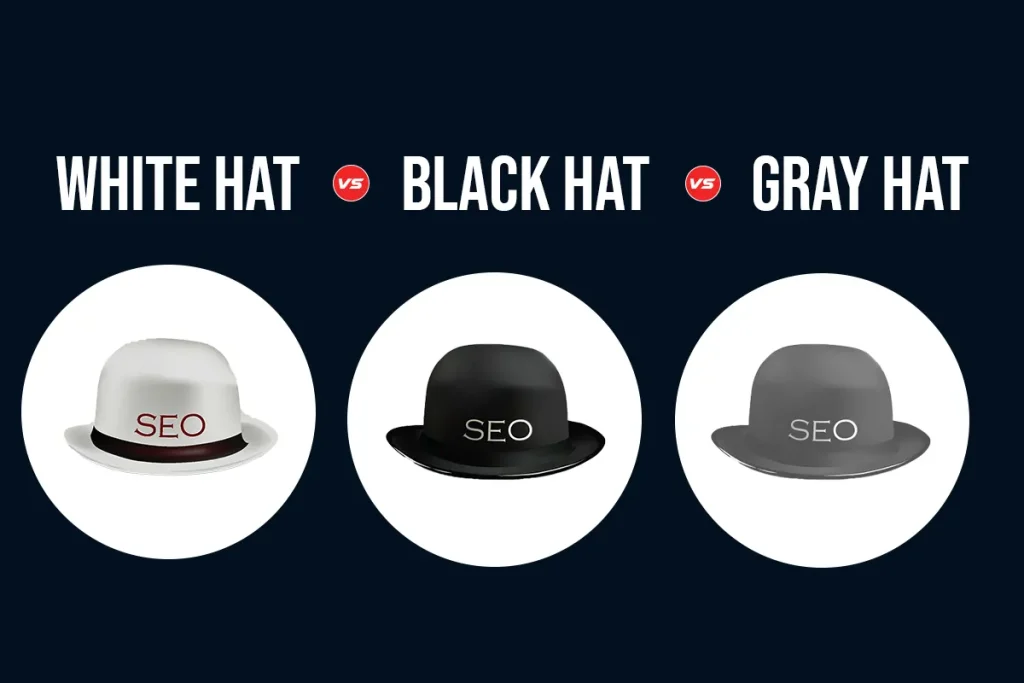Good and evil, light and dark, black and white. The binary exists to point out who’s in the wrong and who’s in the right. Black hat, white hat, and gray hat symbolism was first adopted in the cybersecurity world. In SEO, too, we use white hat vs. black hat vs. gray hat SEO to classify the types of techniques. What makes them different, and what do they mean for your website’s success? Keep reading to find out.
The Origin of the Black Hat and White Hat SEO

In Western movies in the 1920s, it was sometimes difficult for audiences to tell the hero apart from the villain, especially in high-speed action scenes. To solve this issue, filmmakers adopted a unique costume cue—they made the hero wear a white cowboy hat, while the villain wore a black one.
While this storytelling device didn’t stick around for long, cybersecurity professionals adopted the black and white hat symbolism to distinguish ethical hackers from malicious ones. Following suit, SEO professionals also use ‘black hat’ and ‘white hat’ to refer to malicious and ethical SEO techniques, respectively.
What Is White Hat SEO?
White Hat SEO involves following all the guidelines and rules laid down by search engines. You use ethical tactics to build your website’s ranking. You build site authority by creating valuable content and optimizing your website for both users and search engine crawlers.
Creating High-Quality Content
Publishing high-quality content that is relevant to visitors is one of the best tactics to improve search engine ranking. Any posts, blogs, videos, and pages that provide value to users can help boost your SERP rankings.
Earning High-Quality Backlinks From Authoritative Sites
Guest-posting and collaborating with relevant, high-authority websites can help boost your site’s authority. Reaching out to reputed websites that may be interested in linking your content can also help you create organic backlinks that make your website a trusted authority.
Follow Search Engine Guidelines
Search engines are very forthcoming with tactics they reward and those that they penalize. Stay updated on search engine webmaster guidelines and don’t engage in black hat SEO techniques.
Technical SEO
To stay on top of the rankings, optimize all technical SEO components. This includes mobile optimization, using meta tags, URL structure, adding alt text to images, and improving page load times.
At Apex Infotech, we believe that ethical SEO isn’t just good practice; it’s the only smart choice. We use white-hat strategies to help our clients build trust, authority, and rankings that last.
What Is Black Hat SEO?

Unlike white hat SEO, black hat SEO involves trying to improve your website ranking through unethical means and risky practices. It attempts to deceive search engines into believing that your website has more authority or relevance than it really does.
Ultimately, black hat SEO is penalized because it’s an attempt at deceiving search engines and optimizing your website to manipulate SERP rankings instead of providing value and a good user experience to visitors. Here are some black hat SEO techniques:
Keyword Stuffing
Keyword stuffing involves repeating or cramming keywords in content even when it’s irrelevant, in a bid to rank higher.
Keyword stuffing looks spammy and unnatural and spoils the user experience for visitors. It ruins the flow of content and fails to provide any value to users. Search engines can easily detect this black-hat tactic and may eventually end up penalizing you for it.
Paid Links/Link Exchange
Perhaps the most famous example of Black hat SEO is when American department store chain J.C. Penney used 2,015 paid links placed on hundreds of sites that all redirected to a relevant J.C. Penney page.
While this strategy brought the store a lot of traffic during the holiday season, they were penalized by Google taking ‘manual action’ against them and demoting their website in SERPs.
Buying, selling, and trading links are all against Google webmaster policy—regardless of what SEO professionals would like to believe. Of course, whether Google can differentiate such links from natural links is another question altogether.
While Google doesn’t support paid links, it does acknowledge that buying and selling links is common practice. As such, it demands that any paid links must be qualified with a rel=”nofollow” or rel=”sponsored” attribute value to the <a> tag so that it doesn’t pass PageRank.
Link Farms
A link farm is a network of sites that link only to each other with the intention of manipulating PageRank.
Private Blog Networks
Private blog networks (PBNs) are blogs that are created for the sole purpose of generating backlinks to other websites. These blogs usually have thin, spammy content that may be poorly written or AI-generated.
PBNs are similar to link farms, but while link farms only link to each other, PBNs link to other websites and share link juice with them.
Automated Content
Using software or AI to generate content is fine, but publishing it to your website without human editing isn’t. Plus, due to the tendency of AI engines to ‘hallucinate’ facts, AI-generated content that isn’t fact-checked can include misinformation.
Google may penalize AI- or software-generated content if it is spammy, repetitive, low quality, inaccurate, or keyword-heavy.
Hidden Text
This tactic involves hiding text from users by making it the same color as the background, hiding it off-screen, or adding it in a small font size. This text is only visible to search engine crawlers, who are manipulated to believe that the page has more relevant content on certain keywords than it really does.
Acceptable Hidden Content:
- Accordion-style or tabbed content
- Sliders that alternate between images or text
- Relevant text that improves the experience for those using screen readers
- Tooltip or similar text that displays additional content when users interact with over an element
Not Acceptable:
- White text on a white background
- Hiding text behind an element
- Setting font size or opacity to 0
- Using CSS to position text off-screen
- Hiding a link by only linking one small character—for example, a hyphen in the middle of a paragraph
Sneaky Redirects
Sneaky redirects involve showing either search engines and visitors different content or showing visitors content that is different from what they originally requested. Such redirects are used to pass link juice from one page to the other.
Cloaking
Cloaking involves cloaking or disguising content to present visitors and search engines with different content or URLs. This is usually done to manipulate search engine rankings or deceive visitors. For example, showing search engines a page about ‘shoes’ while showing users a gambling page.
Black hat SEO is riskier, but it offers benefits in the short term. That’s why it’s still popular among certain SEO professionals. While tempting, black hat SEO tactics carry serious risks that can damage your site’s credibility and visibility.
What is Gray Hat SEO?
What do you get when you mix black and white? Gray, of course. Gray hat SEO blurs the lines between black hat and white hat SEO techniques. While not completely against search engine guidelines, it uses loopholes to traverse the middle ground between ethical and deceptive SEO techniques.
Simply put, gray hat SEO techniques aren’t (currently) penalized offenses by Google, but they are shady and deceptive at best. What’s more, they could definitely become punishable in the future.
Fake Reviews
Many businesses resort to posting fake reviews online to give their products or services some credibility. While posting fake reviews or paying for them may not be penalized instantly, it does violate platform policies and can result in penalties or removals. It is highly unethical and not really something you can proudly reveal to Google.
Expired Domain Abuse
In expired domain abuse, you purchase a domain that has already expired and repurpose this domain to manipulate SERPs. You could do this by hosting content on this domain that is not relevant or useful for visitors.
Link Schemes
Link schemes involve building or buying links to manipulate search engine rankings. Often these links aren’t relevant and don’t add any value to your website. Examples of link schemes include paid links, link exchanges or trades, and spamming links in comments.
Doorway Pages
Doorway pages are pages that are optimized for certain keywords with low-quality content. They only exist to redirect visitors to the relevant page.
As you may already know, creating content for search engines rather than users can backfire for you. Once Google realizes that your doorway pages are manipulating SERP rankings, it will penalize your website for using this gray hat tactic.
Spun Content
Content spinning, aka spun content, is essentially ‘repurposing’ someone else’s content by rewriting it sentence by sentence. While this may not register as plagiarism, it is definitely unethical. It’s usually used to help your website rank for certain keywords.
Differences Between White Hat vs. Black Hat vs. Gray Hat SEO
Here’s a quick summarization of the difference between white hat SEO and black hat SEO, and where gray hat SEO comes in.
| Category | White Hat SEO | Black Hat SEO | Gray Hat SEO |
| Guidelines | Not against search engine guidelines | Against search engine guidelines | Not against search engine guidelines, but could be in the future |
| Risk | Low to none | High | Medium |
| Longevity | Long-term | Short-term, can result in penalties, bans, or de-indexing | Medium-term, some tactics may be not be sustainable |
| Ranking Speed | Slow and gradual | Fast, but unsustainable | Moderate |
| Techniques | – Creating High-Quality Content – Earning High-Quality – Backlinks from Authoritative Sites – Follow Search Engine Guidelines – Technical SEO | – Keyword Stuffing – Paid Links/ Link Exchange – Link Farms – Private Blog – Networks – Automated Content – Hidden Text – Sneaky Redirects – Cloaking | – Fake Reviews – Expired Domain Abuse Link Schemes – Doorway Pages – Spun Content |
Which Hat Will You Don?

White hat SEO involves using ethical methods and trying to improve your SERP ranking organically. Black hat SEO goes against search engine guidelines to manipulate rankings, and gray hat SEO takes the middle ground by dabbling in unethical SEO practices but never taking it too far.
Gray hat SEO can be effective, but it can also have long-term consequences. If you’re considering gray hat SEO, remember that short-term benefits may not be worth the risk of penalties in the future.
Although white hat SEO might take longer, it is a sustainable way of increasing your website’s credibility. Focus on creating useful content, and follow SEO guidelines to build authority and dominate search results.
As the best SEO company in Mumbai, Apex Infotech recommends using white hat techniques for the most part, as they will bring you slow but highly sustainable results.
Our team of Mumbai’s leading SEO experts can help you rise in rankings the right way. Let us help you create an SEO strategy that both Google and your users will love!
Frequently Asked Questions
What is the difference between black hat, white hat, and gray hat SEO?
White hat SEO operates according to search engine guidelines. Black hat SEO breaks these guidelines to manipulate results, while gray hat SEO is a mix of both approaches.
Is black hat SEO a good long-term strategy?
No, black hat SEO is not a good long-term strategy, as it goes against search engine guidelines. Your site may be penalized if you use black hat SEO tactics.
What are some examples of black hat SEO tactics?
Some black hat SEO examples include cloaking, Private Blog Networks (PBNs), hidden text or links, keyword stuffing, duplicate content, and clickbait.
Can an SEO agency give me instant rankings?
Agencies that advertise instant rankings and short-term gains with zero risk may use black hat SEO techniques. Black hat is unethical and Google could penalize your website because of it.



